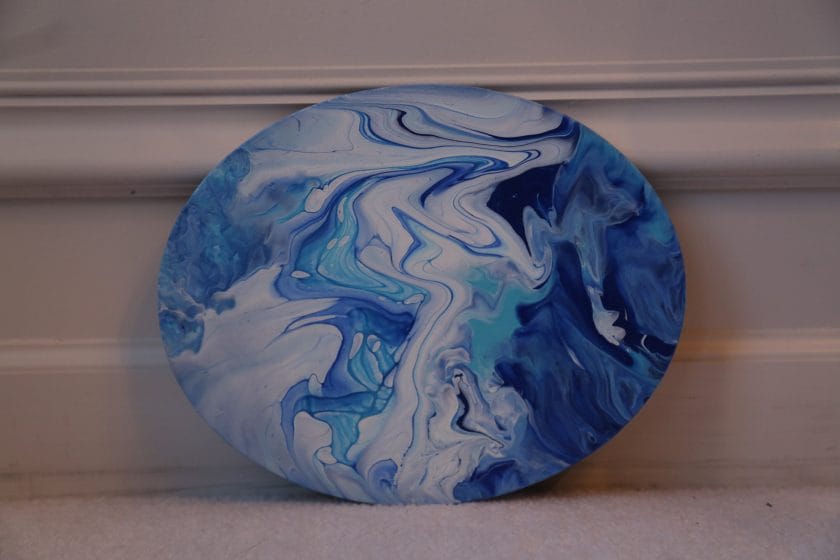Yes, acrylic paint can freeze if exposed to extremely cold temperatures. When frozen, the consistency of the paint can change, causing it to become lumpy or separated. It is important to store acrylic paint in a cool, dry place to avoid freezing. If acrylic paint does freeze, it may be possible to thaw it out and restore its original consistency by gently warming it.

Can Acrylic Paint be Frozen?
Acrylic paint is a popular choice for artists due to its versatility and vibrant colors. However, if you’ve found yourself with leftover paint, you may be wondering if it can be safely stored in the freezer. Let’s explore whether acrylic paint can be frozen and the potential effects it may have on the paint.
Acrylic paint consists of pigments suspended in an acrylic polymer emulsion. When the paint is exposed to air, the water in the emulsion evaporates, leaving a layer of solid pigment. Freezing acrylic paint can alter its consistency and affect its performance.
Effects of Freezing Acrylic Paint:
1. Separation: Freezing and thawing acrylic paint can cause the emulsion to separate. This separation can lead to uneven pigmentation and an inconsistent texture. Shaking or stirring the paint vigorously after thawing may help to reintegrate the separated components.
2. Texture Changes: When acrylic paint is frozen, ice crystals can form within the emulsion, leading to changes in the paint’s texture. Thawing the paint may result in a grainy or lumpy consistency. This texture alteration can impact the paint’s ability to flow smoothly and evenly on the canvas.
3. Color Shift: Freezing can also cause a color shift in acrylic paint. Certain pigments may become muted or change in hue when exposed to extreme temperatures. This can affect the overall appearance and vibrancy of your artwork.
Best Practices for Storing Acrylic Paint:
While freezing acrylic paint is not recommended, there are other storage methods that can help prolong its shelf life:
1. Airtight Containers: Store acrylic paint in airtight containers to minimize exposure to air. This helps prevent the water in the emulsion from evaporating and maintains the paint’s consistency.
2. Temperature Control: Store acrylic paint in a cool, dry place away from direct sunlight and extreme temperatures. Excessive heat can cause the paint to dry out, while extreme cold can affect its texture and color.
3. Labeling and Date: To keep track of the paint’s age, label each container with the color name and the date it was opened. This can help you prioritize older paints and ensure that you use them before they expire.
4. Regular Stirring: If you have acrylic paint that has been sitting for a while, make sure to stir it thoroughly before using. This helps to recombine any separated components and ensures the paint’s consistency is even throughout.
In summary, while it is possible to freeze acrylic paint, it is not recommended due to the potential negative effects on its consistency, texture, and color. It is best to store acrylic paint in airtight containers in a cool, dry place to maintain its quality. By following these storage practices, you can prolong the lifespan of your acrylic paint and continue creating beautiful artworks.
The Effects of Freezing Acrylic Paint
Acrylic paint is a popular medium among artists and hobbyists due to its versatility and fast-drying properties. However, sometimes you may find yourself with leftover paint that you want to store for future use. In such cases, you might wonder if it’s safe to freeze acrylic paint and how it may affect its quality. In this section, we will explore the effects of freezing acrylic paint and provide you with some guidelines for proper storage.
1. Changes in Consistency
Freezing acrylic paint can have an impact on its consistency and overall texture. When you freeze the paint, the water content within it expands and forms ice crystals. As a result, the paint may become thicker and less fluid once thawed. This change in consistency can make it challenging to work with, especially if you prefer a more liquid consistency for your artwork.
2. Separation of Components
Another potential effect of freezing acrylic paint is the separation of its components. Acrylic paint consists of pigment particles suspended in a binder medium. Freezing and thawing can cause these components to separate, resulting in an uneven distribution of pigment and binder. This separation can lead to a patchy, inconsistent application of paint on your canvas.
3. Altered Color Vibrancy
The freezing process can also impact the vibrancy of the colors in acrylic paint. Some pigments may be more prone to fading or shifting when subjected to extreme temperatures. Freezing can potentially alter the color intensity and hue of the paint, diminishing its original vibrancy. Consequently, your artwork may not achieve the desired visual impact if you use previously frozen and thawed acrylic paint.
4. Compromised Adhesion
One crucial aspect of acrylic paint is its ability to adhere well to various surfaces. Freezing the paint can compromise this adhesion property. The expansion and contraction caused by freezing and thawing can weaken the bonds between the paint and the surface, leading to issues such as peeling, cracking, or flaking. If you plan to use the paint for a project that requires strong adhesion, it’s advisable to avoid freezing it.
5. Storage Recommendations
While freezing acrylic paint may not be ideal, proper storage can help extend its shelf life without compromising its quality. Here are some recommendations for storing your acrylic paint:
- Store the paint in a cool, dry place away from direct sunlight.
- Ensure the containers are tightly sealed to prevent air exposure.
- If you have a small amount of leftover paint, consider transferring it to smaller containers to minimize the amount of air trapped inside.
- Label the containers with the date of storage to keep track of their freshness.
By following these storage guidelines, you can maximize the lifespan of your acrylic paint and maintain its optimal quality for future use.
Summary
While it is technically possible to freeze acrylic paint, it can have several adverse effects on its consistency, separation of components, color vibrancy, and adhesion. It is generally recommended to avoid freezing acrylic paint if possible. Instead, focus on proper storage techniques, such as keeping the paint in a cool, dry place and tightly sealed containers, to preserve its quality for longer periods. By taking these precautions, you can ensure that your acrylic paint remains in good condition and ready to use whenever inspiration strikes.
Tips for Storing Acrylic Paint in Cold Temperatures
Acrylic paint is a versatile and popular medium that is used by artists and hobbyists alike. However, one challenge that acrylic paint enthusiasts often face is storing their paint in cold temperatures. Cold weather can have a detrimental effect on the quality and consistency of acrylic paint if it is not stored properly. In this section, we will discuss some tips and guidelines for storing acrylic paint in cold temperatures.
1. Keep the Paint in a Stable Environment
Acrylic paint should be stored in a stable environment, preferably between 60°F and 75°F (15°C and 24°C). Exposure to extreme cold temperatures can cause the paint to freeze, affecting its texture and color. It is important to store acrylic paint in a place where the temperature remains consistent, such as a heated room or a temperature-controlled storage area.
2. Avoid Freezing and Thawing
Freezing and thawing cycles can have a negative impact on the quality of acrylic paint. When acrylic paint freezes, the water-based emulsion can break down, leading to clumping and separation of pigments. To avoid this, make sure to store your paint in a location where it won’t be subject to freezing temperatures. If your paint does accidentally freeze, allow it to thaw completely at room temperature before using it.
3. Protect the Paint Tubes
Acrylic paint is typically sold in tubes, and these tubes can be affected by cold temperatures. When storing your paint, make sure to keep the tubes tightly sealed to prevent any moisture from entering. Moisture can lead to a change in the consistency and quality of the paint. Additionally, it is recommended to store the tubes in airtight containers or zip-lock bags to provide extra protection against moisture and temperature fluctuations.
4. Shake Well Before Use
If you have stored your acrylic paint in cold temperatures, you might notice that the consistency has become thicker and separated. Before using the paint, make sure to shake the tubes vigorously to mix the pigments and binders back together. This will help restore the original consistency of the paint and ensure smooth application.
5. Store Paint Upside Down
When storing acrylic paint tubes, it is also helpful to store them upside down. This technique can prevent air from entering the tube and drying out the paint. By storing the tubes upside down, gravity helps keep the paint close to the opening, making it easier to squeeze out without any air bubbles or dried-out pigment.
6. Consider a Portable Storage Solution
If you often work in different locations or need to transport your paint, consider investing in a portable storage solution. There are various options available, such as paint storage boxes or bags with compartments designed to hold paint tubes securely. These storage solutions not only protect your paint from cold temperatures but also keep them organized and easily accessible.
Summary
Storing acrylic paint in cold temperatures requires some extra care and attention to maintain its quality and usability. Remember to store the paint in a stable environment, protect the tubes from moisture, shake the paint well before use, and consider using a portable storage solution for added convenience. By following these guidelines, you can ensure that your acrylic paint remains in optimal condition even in cold weather.
Thawing Frozen Acrylic Paint
If you’re an artist or enjoy painting as a hobby, you may have encountered the frustrating situation of finding your acrylic paint frozen. Freezing can occur if you store your paint in a cold environment or accidentally leave it outside during the winter months. Frozen acrylic paint can become unusable and may require some steps to restore it to its original consistency. In this section, we will explore different methods for thawing frozen acrylic paint.
1. Bringing the Paint to Room Temperature
The first method to try is simply allowing the frozen acrylic paint to thaw naturally at room temperature. Remove the paint from the cold environment and place it in a warm area of your home, away from direct sunlight. It’s important to note that this method may take several hours or even days, depending on the temperature and the size of the paint container. Patience is key with this method as forcing the thawing process may damage the paint.
2. Use Warm Water Bath
If you need to thaw the paint more quickly, you can use a warm water bath. Fill a container with warm (not hot) water and place the frozen acrylic paint bottle or tube into the water. Ensure that the container is sealed to prevent water from seeping into the paint. Leave the paint submerged for around 15-20 minutes, periodically checking its consistency. Once the paint has thawed, remove it from the water bath and dry the container thoroughly before opening.
3. Gentle Heating Method
For those who prefer a more controlled approach, using gentle heat can speed up the thawing process. Start by placing the frozen paint container in a plastic bag to protect it from direct heat. Then, gently warm the container using a hairdryer on its lowest setting or a heat lamp placed at a safe distance. Keep the heat source moving to avoid excessive heat in one area. Monitor the paint’s temperature while using this method to prevent overheating and damage to the paint. Once the paint has thawed, let it cool down before opening the container.
4. Stir and Test
After thawing the acrylic paint using any of the methods mentioned above, it’s essential to thoroughly stir the paint to ensure it’s fully mixed and back to its original consistency. Use a wooden stick or palette knife to stir the paint gently until it appears smooth and uniform. Once mixed, perform a small test on a scrap piece of material or canvas to check the paint’s texture and color. This step will help you determine if the paint is ready for use or if it requires further adjustments.
By following one of these methods, you can effectively thaw your frozen acrylic paint and bring it back to a usable state. Remember to store your acrylic paint in a suitable location to prevent future freezing. Proper storage at room temperature will help maintain the paint’s quality and extend its shelf life.
Best Practices for Preventing Freezing of Acrylic Paint
Acrylic paint is a popular choice among artists due to its versatility, vibrant colors, and quick drying time. However, one common concern when working with acrylic paint is the possibility of freezing, especially in colder temperatures. Freezing can affect the quality and consistency of the paint, making it difficult to work with. To prevent freezing and preserve the integrity of your acrylic paint, follow these best practices:
1. Store in a Climate-Controlled Environment
Acrylic paint should be stored in a dry and climate-controlled environment to prevent freezing. Ideally, the temperature should be between 65°F and 75°F (18°C and 24°C) to ensure the paint remains in good condition. Avoid storing acrylic paint in areas that experience extreme temperature fluctuations, such as garages or basements.
2. Avoid Exposure to Freezing Temperatures
When transporting or storing acrylic paint, it is crucial to protect it from freezing temperatures. Freezing can cause the water in the paint to expand, leading to clumping and separation of the pigments. If you need to transport your acrylic paint during the winter months, ensure it is well-insulated and shielded from cold temperatures.
3. Use Sealable Containers
Properly sealing your acrylic paint containers is essential for preventing freezing. Air-tight containers, such as jars or bottles with screw-on lids, can help maintain a consistent temperature and prevent moisture from entering. Ensure the containers are tightly sealed after each use to minimize the risk of freezing.
4. Keep Paint in Moderate-Sized Containers
Dividing your acrylic paint into smaller, moderate-sized containers can help prevent freezing. By reducing the volume of paint in each container, you decrease the chances of the paint freezing throughout. Additionally, using smaller containers allows for better control and organization of your acrylic paint collection.
5. Rotate Paint Inventory
To avoid having acrylic paint sit unused for extended periods, it is advisable to rotate your paint inventory regularly. By using the older paint first and replenishing your stock with fresh paint, you ensure that the paint remains in good condition and less susceptible to freezing. This practice also helps to maintain a consistent quality and pigment saturation in your artwork.
6. Thaw and Stir Properly
If you accidentally expose your acrylic paint to freezing temperatures, do not panic. Allow the paint to thaw naturally at room temperature for at least 24 hours. Once thawed, thoroughly stir the paint using a palette knife or a stir stick to reincorporate any separated pigments. Avoid using excessive force or heat to speed up the thawing process, as it may affect the paint’s consistency.
7. Test Thawed Paint
After thawing and stirring your acrylic paint, it is crucial to test its consistency and performance before using it in your artwork. Apply a small amount of paint to a test surface and observe its texture, color, and drying time. If the paint has been significantly compromised due to freezing, it may be best to discard it and use fresh paint for optimal results.
In summary, preventing the freezing of acrylic paint requires appropriate storage, protection from extreme temperatures, and proper thawing techniques. By following these best practices, you can ensure that your acrylic paint remains in excellent condition and ready to create stunning artworks.

FAQs
Can acrylic paint freeze?
Yes, acrylic paint can freeze if exposed to extremely low temperatures. Freezing can cause the paint to separate and become unusable. It is best to store acrylic paint in a cool, dry place above freezing temperatures.

Conclusion
In conclusion, while acrylic paint can freeze, it is important to note that freezing temperatures can have a negative impact on its quality and consistency.
When acrylic paint freezes, it can undergo texture changes and become lumpy or grainy. The expansion and contraction during freezing and thawing can also cause the paint to crack or separate. Therefore, it is recommended to store acrylic paint in a cool, dry place above freezing temperatures to maintain its integrity.
By taking proper storage precautions, you can ensure that your acrylic paint remains in optimal condition for your artistic endeavors.
